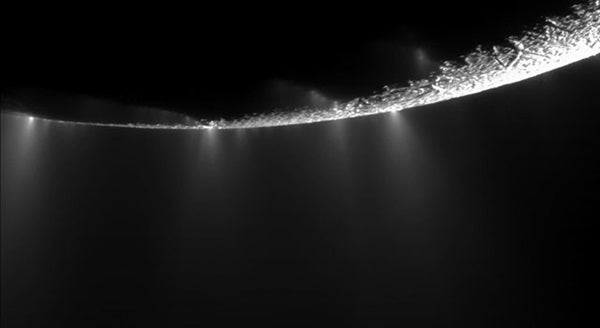Observations of how Saturn’s moon Enceladus interacts with its environment show it leaves a complex pattern of ripples and bubbles in its wake. Sheila Kanani of University College London’s Mullard Space Science Laboratory presented the results at the Royal Astronomical Society National Astronomy Meeting in Glasgow on Thursday.
Enceladus sits deep within Saturn’s magnetosphere, which is filled with electrically charged particles (plasma) originating from both the planet and its moons. The Cassini spacecraft has made nine flybys of the mysterious sixth-largest moon since 2005. The closest of these have taken the spacecraft’s suite of instruments just 15 miles (25 kilometers) from Enceladus’ surface, which many scientists believe conceals a saline ocean. Heated vents at the south pole of the moon release a plume of material, consisting mainly of icy grains and water vapor, into space.
Measurements from the Cassini Plasma Spectrometer (CAPS) and the Magnetospheric IMaging Instrument (MIMI) show that both the moon and its plume are continuously soaking up the plasma, which rushes past at around 19 miles (30 km) per second, leaving a cavity downstream. In addition, the most energetic particles that zoom up and down Saturn’s magnetic field lines are swept up, leaving a much larger void in the high-energy plasma. Material from Enceladus, both dust and gas, is also being charged and forming new plasma.
Now, Kanani and a team at the Mullard Space Science Laboratory have discovered mysterious spiky features in the CAPS data that present a complex picture of readjustment downstream from Enceladus.
“Eventually, the plasma closes the gap downstream from Enceladus, but our observations show that this isn’t happening in a smooth, orderly fashion,” said Kanani. “We are seeing spiky features in the plasma that last between a few tens of seconds and a minute or two. We think that these might represent bubbles of low-energy particles formed as the plasma fills the gap from different directions.”
Since Cassini arrived at Saturn, it has been building up a picture of the vital and unexpected role that Enceladus plays in Saturn’s magnetosphere. Enceladus may play a role similar to Jupiter’s moon Io, which pumps plasma into Jupiter’s environment. A picture of plasma adjustments in the wake of Enceladus could provide clues to how plasma gets transported around the saturnian environment.
“Enceladus is the source of most of the plasma in Saturn’s magnetosphere, with ionized water and oxygen originating from the vents forming a big torus of plasma that surrounds Saturn,” Kanani said. “We may see these spiky features in the wake of Saturn’s other moons as they interact with the plasma, but, to date, we have only studied Enceladus in sufficient detail.”










